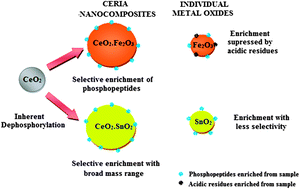Ceria-based nanocomposites for the enrichment and identification of phosphopeptides†
Abstract
Nanocomposites are given preference over the individual materials due to the combined properties of the components involved. Ceria has a high efficiency in phosphopeptide enrichment as well as in dephosphorylation. Iron oxide and tin oxide are chosen as counter metal oxides to synthesize the ceria nanocomposites using a co-precipitation method. The nanocomposites are characterized by Fourier-transform infrared spectroscopy (FT-IR) and scanning electron microscopy (SEM). Tryptic β-casein digest shows the feasibility of phosphopeptide enrichment by the two nanocomposites. Selectivity studies show their performance in comparison to ceria. Being more selective in the extended mass range, both nanocomposites are applied to spiked human serum and non-fat milk digest. The ceria nanocomposites are also capable of being used as material-enhanced laser desorption/ionization (MELDI) carrier/affinity materials for real biological samples with varying degrees of complexity. The enriched content is analyzed by MALDI-TOF MS. All the phosphopeptides in all variants of casein are identified. The sequence coverage of caseins is also interpreted. Nanocomposites thus offer a high selectivity and sensitivity, which make them promising materials for biomarker discoveries and the identification of phosphorylation pathways for new post translational modifications (PTMs).


 Please wait while we load your content...
Please wait while we load your content...